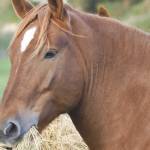Laminitis Risk Strongly Linked to Underlying Disease in Horses

For decades, horse owners have struggled with management of chubby, cresty horses. The horses have been muzzled, secured in drylots, and kept off fresh grass and grain in attempts to keep them from developing laminitis. Despite the best efforts, these horses frequently succumbed to the crippling condition. Recent research offers an explanation that may absolve some of the guilt experienced by owners of foundered horses.
Conducted at the University of Helsinki in Finland, the study showed that almost 90% of horses admitted to the school’s clinic because of laminitis had some sort of underlying endocrine disease such as Cushing’s syndrome of equine metabolic syndrome. Horses with these conditions are far more likely than unaffected horses to develop laminitis, and even the most careful management strategies may not be sufficient to prevent its onset.
Among the affected study subjects, it was found that older horses (12 years or more) and ponies were at greater risk for laminitis. Not all equines showed easily recognizable endocrine disease signs such as obesity or a heavy hair coat. Some were overweight, but their owners didn’t recognize them as such, thinking the horses simply looked healthy.
Ninja Karikoski, D.V.M., who led the study, suggested that owners of older, obese, or laminitic horses should get endocrinologic testing for their equines so that future management and treatment strategies can be put into practice. Careful management decreases, but does not eliminate, the risk of laminitis for susceptible horses.








